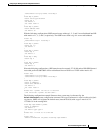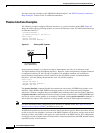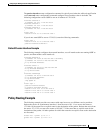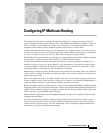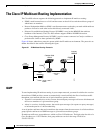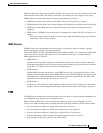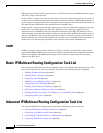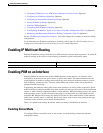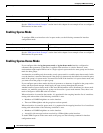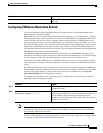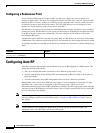
IPC-399
Cisco IOS IP Configuration Guide
Configuring IP Multicast Routing
This chapter describes how to configure IP multicast routing. For a complete description of the IP
multicast routing commands in this chapter, refer to the “IP Multicast Routing Commands” chapter of
the Cisco IOS IP Command Reference, Volume 3 of 3: Multicast. To locate documentation of other
commands in this chapter, use the command reference master index, or search online.
Traditional IP communication allows a host to send packets to a single host (unicast transmission) or to
all hosts (broadcast transmission). IP multicast provides a third scheme, allowing a host to send packets
to a subset of all hosts (group transmission). These hosts are known as group members.
Packets delivered to group members are identified by a single multicast group address. Multicast packets
are delivered to a group using best-effort reliability, just like IP unicast packets.
The multicast environment consists of senders and receivers. Any host, regardless of whether it is a
member of a group, can send to a group. However, only the members of a group receive the message.
A multicast address is chosen for the receivers in a multicast group. Senders use that address as the
destination address of a datagram to reach all members of the group.
Membership in a multicast group is dynamic; hosts can join and leave at any time. There is no restriction
on the location or number of members in a multicast group. A host can be a member of more than one
multicast group at a time.
How active a multicast group is and what members it has can vary from group to group and from time
to time. A multicast group can be active for a long time, or it may be very short-lived. Membership in a
group can change constantly. A group that has members may have no activity.
Routers executing a multicast routing protocol, such as Protocol Independent Multicast (PIM), maintain
forwarding tables to forward multicast datagrams. Routers use the Internet Group Management Protocol
(IGMP) to learn whether members of a group are present on their directly attached subnets. Hosts join
multicast groups by sending IGMP report messages.
Many multimedia applications involve multiple participants. IP multicast is naturally suitable for this
communication paradigm.
To identify the hardware platform or software image information associated with a feature, use the
Feature Navigator on Cisco.com to search for information about the feature or refer to the software
release notes for a specific release. For more information, see the “Identifying Supported Platforms”
section in the “Using Cisco IOS Software” chapter.



